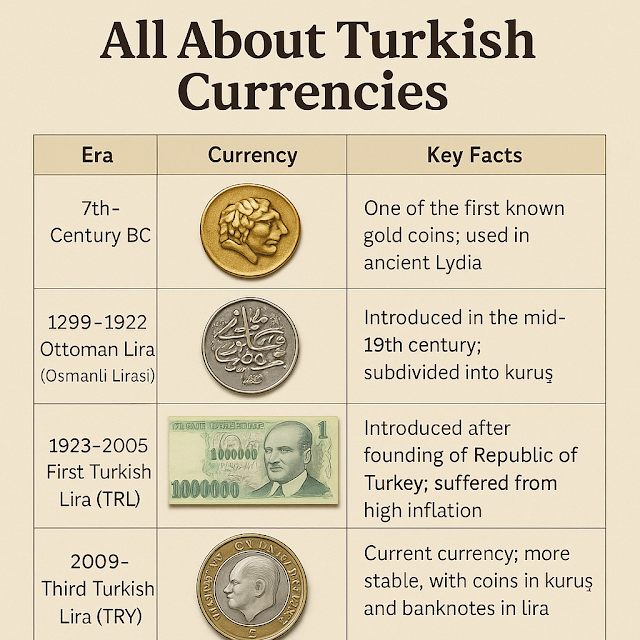 |
| Turkish Currencies |
Turkey has a rich and diverse history, and its currencies have evolved significantly over the centuries—reflecting the economic, political, and cultural shifts in the region. From the Lydian stater, one of the world’s first coins, to the modern Turkish lira (TRY), the journey of Turkish currency is both fascinating and complex.
🪙 A Brief History of Turkish Currencies
| Era | Currency | Key Facts |
|---|---|---|
| 7th Century BC | Lydian Stater | One of the first known gold coins; used in ancient Lydia (modern-day western Turkey). |
| 1299–1922 (Ottoman Empire) | Ottoman Lira (Osmanlı Lirası) | Introduced in the mid-19th century; subdivided into kuruş. Used throughout the vast Ottoman Empire. |
| 1923–2005 | First Turkish Lira (TRL) | Introduced after the founding of the Republic of Turkey; suffered from high inflation and devaluation. |
| 2005–2008 | Second Turkish Lira (YTL) | Introduced through a currency redenomination (1 YTL = 1,000,000 TRL). Helped combat hyperinflation. |
| 2009–Present | Third Turkish Lira (TRY) | Current currency; more stable, with coins in kuruş and banknotes in lira. Symbol: ₺ |
🇹🇷 Modern Turkish Lira (TRY)
-
Currency Code: TRY
-
Symbol: ₺
-
Subunit: 1 lira = 100 kuruş
-
Issued by: Central Bank of the Republic of Turkey (CBRT)
-
Common Coins: 5, 10, 25, 50 kuruş, and ₺1
-
Banknotes: ₺5, ₺10, ₺20, ₺50, ₺100, ₺200
-
Monetary Policy Authority: www.tcmb.gov.tr
📉 Inflation and Currency Changes
The Turkish lira has experienced periods of high inflation, especially during the late 20th century. This led to:
-
Frequent devaluation of the currency
-
Introduction of multiple denominations
-
Two major redenominations (2005 & 2009)
The 2005 reform removed six zeros from the old currency, significantly simplifying financial transactions and increasing global confidence.
🌍 Use of Foreign Currencies in Turkey
Although the Turkish lira is the official and most commonly used currency, other major currencies are widely accepted in certain regions:
| Currency | Where It's Used | Notes |
|---|---|---|
| Euro (EUR) | Border areas with the EU, luxury hotels, and tourist hubs | Especially common in Antalya, Istanbul, and Cappadocia |
| US Dollar (USD) | International hotels, shopping centers, airports | Preferred for larger transactions or property purchases |
Foreign currencies are usually accepted in tourist-heavy areas, but using TRY is more cost-effective due to better exchange rates and fewer commissions.
💡 Tips for Travelers & Forex Users
-
Always check exchange rates from trusted platforms or local banks before conversion.
-
Avoid exchanging currency at airports, as rates are usually less favorable.
-
ATMs in Turkey commonly offer TRY, but may also allow EUR or USD withdrawals in tourist zones.
-
Consider using digital wallets or cards (Wise, Revolut, etc.) to save on conversion fees.
🔚 Conclusion
The evolution of Turkish currencies—from the Lydian gold stater to the modern Turkish lira (₺)—tells a story of innovation, resilience, and adaptation. Each era's currency reflects Turkey’s unique position at the crossroads of Europe and Asia, and its economic transformation over time.
Whether you're a traveler, a history buff, or simply curious about global currencies, understanding Turkey's monetary history offers insight into the nation’s economic journey.
📌 FAQs
Q: What is the current exchange rate of TRY to USD or EUR?
A: It fluctuates frequently. Please check XE, OANDA, or local bank websites for real-time rates.
Q: Is the Turkish lira stable now?
A: While it has stabilized since the 2009 reform, the lira still faces periodic devaluation due to inflation and geopolitical factors.
Q: Can I pay in euros in Istanbul?
A: Yes, but it’s better to use TRY for favorable rates unless you're in high-end tourist locations.






No comments:
Post a Comment